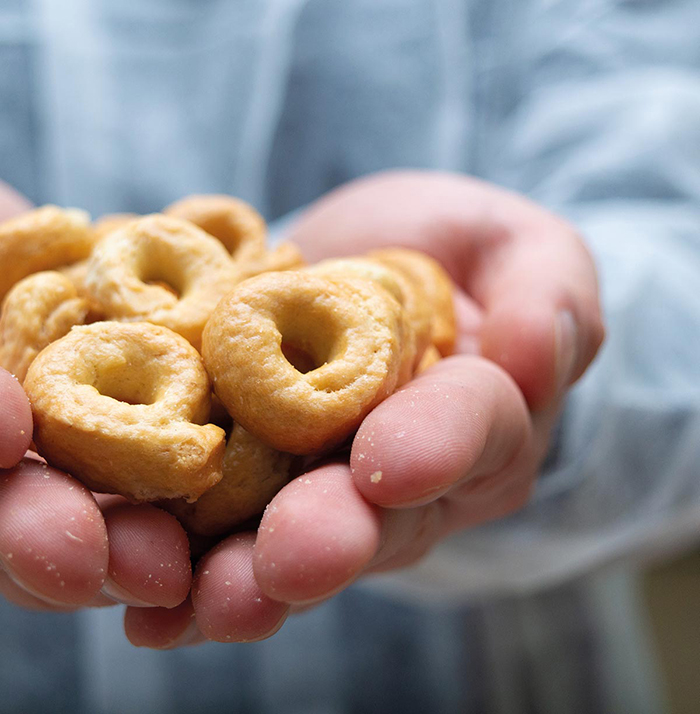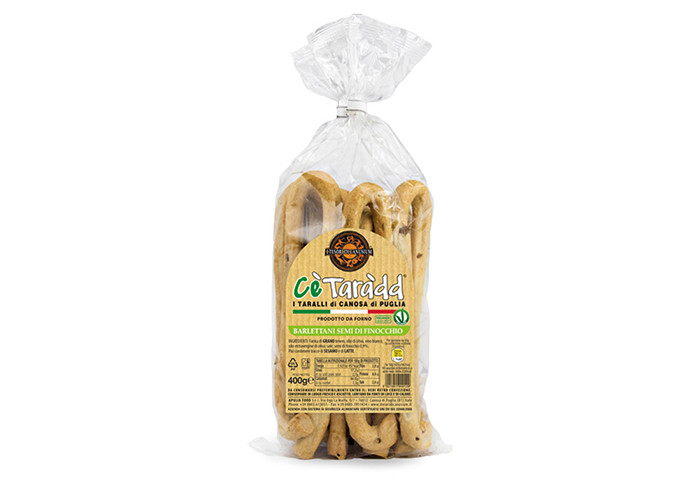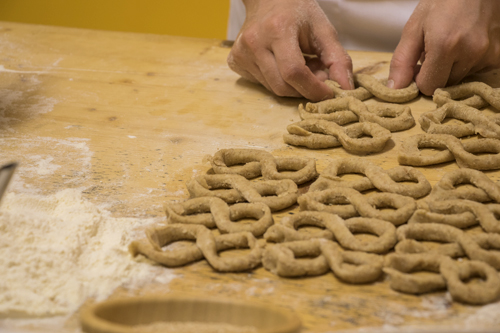- Per gli ordini a partire da 50€ (Italia) SPEDIZIONE GRATUITA!

PRODEXPO 2019: Moscow here we come!
28 March 2019VeePN.co How to change VPN into japan
4 September 2019
The story of a representative who one day decided to get to know the Apulian taralli.
Nunzio Margiotta’s office tells the story of Nunzio Margiotta. We are in Canosa di Puglia in the Apulia Food plant, a company with a fairly good history but which has already established itself among the first in the Italian artisan taralli sector with the brands “Ce ‘Taradd” and “I Tesori di Canusium”.
Let us at the door of the universe of Nunzio, the same sixty-year-old gentleman who appears in the Telenorba spot, imposing and elegant at the same time. Peace look. On one side of his room the look falls on the sacred icons in plain sight, while on another wall the smiles of the grandchildren appear. Behind the desk, framed, a beautiful wheat field of Tavoliere delle Puglie. The perfect summary to tell this story.
Nunzio Margiotta set up this Can plant in 2005. Here only handmade taralli are produced. The recipes of the past, those of mothers, only those. Here are the rule. For the rest, we are talking about an entrepreneurial reality that has forty-seven employees, two production lines, one completely automated (which will soon be transferred to a new factory in Barletta) and another made of arms and hands. In total 10 quintals of taralli per hour and about 110 quintals of processed flour per day. “As a turnover, we are among the first in Italy,” explains Margiotta.

How did the idea of producing only taralli come about?
We are born because the taralli market in Italy was orphan of the true tradition of taralli. The products marketed were passed off as artisans but when I happened to ask an opinion to several consumers in northern Italy, the answer I received was often that those taralli didn’t like them. They had never eaten the real artisan tarallo.
In the end, did you manage to get the true Apulian tarallo known?
We are the last born, we started in February 2005, yet we are the ones who have made more progress than others, because of the past experience, because of the quality, the seriousness and the service that we can give. I would dare to say that we have obtained an excellent response. We distribute taralli in almost all of Italy: the great players of large retailers are our customers, from Esselunga to Auchan, passing through Aspiag. I think I can say, even with a touch of pride, that our taralli are the best distributed in the national territory. On the motorway we are present throughout the “Sarni” network.
Outside Italy?
Abroad is not very important for me, the first step is to be known on the national territory. Export can be more, but we are not looking for it at all costs. Today for us it represents about 7-8 percent of turnover, little respect to other competitors better known abroad than in Italy.
What was your job before you started making taralli?
I was a commercial agent and distributor in the area of confectionery and other typical Apulian products. I turned to some factories in the area and had my own production of orecchiette, friselle, taralli and other Apulian specialties that I distributed in the Foggiae area of Bari with one of my brands, “I Tesori di Canusium”, a brand that was born in 1985.
How did the decision to move from distribution to production come?
When I started to distribute beyond the regional borders, I found myself at a crossroads: to continue to be a small merchant, or to make a qualitative leap and become a producer by focusing on much wider horizons. I found myself not in front of a new need, but a new dream. Today I can say that I do the activity I always wanted to do.
In this passage, however, he has never betrayed the initial spirit: keeping faith with the craftsmanship of the product, authenticity and the link with the territory.
If in other areas of Italy they can boast products that are recognized as excellences all over the world it is because they continue to produce them according to the traditional methods of tradition. This is the spirit that led me to produce Apulian taralli.
An activity and a story that come from far away …
Mine is a story born of economic needs. My father passed away at a very young age and in those days my mother, in order not to go to work and submit to the criticisms that could have been addressed to her, preferred to work at home, earn less, but keep faith with her honor. Here in Canosa we had the local wood-fired ovens, many women had lost the habit of making bread at home, my mother prepared on commission bread, taralli, Christmas cakes, Easter cakes for the people in the vicinity. It was not a commercial activity as it could be understood today, but only a means of sustenance that together with retirement allowed her to go ahead and raise two small children. While I was studying, I helped her out with those that were my possibilities.
What has struck you about that experience that makes it a reason for living?
It was not a shock. I grew up among flour and recipes, I acquired an important gastronomic culture and when I started my business I brought my experience into my daily work. I tell you a fact that can say more than anything else. Between Canosa and Cerignola the burnt wheat is a well-known flour, we are in the low Tavoliere and since we were children we have grown with the strascinate of burnt wheat. I remember that my mother used to make bread here in Canosa we call “prosciutto bread” in dialect, half white and half dark. Today we are proud to have been the first to produce burnt-wheat taralli in Italy. At the beginning many people advised me against this new line, since no one in Northern Italy knew what burnt wheat was. Today, on the other hand, everyone fell in love with our taralli with burnt wheat and they all started producing them. “TODAY OUR VENIS IS TO BE THE FIRST TO PRODUCE TARALLI IN ITALY IN THE GRANO ARSO”
In short, I understand that in addition to tradition there is also courage to innovate.
I say this with a touch of pride: we are the last born on the market, our goal we have not yet reached, there is always a new challenge to face, yet we are the ones who are burning stages most of all. Today we are the most imitatisia for the forms, both for tastes. We have also brought innovation to the flavors, but always drawing on recipes from the Apulian and Italian culinary tradition. I’ll give you another example: first we invented the taralli cacio e pepe, a tasty, typically Roman, burina recipe, even in this case we started when many didn’t even know what “cacio e pepe” meant. Then we invented the potatoes and rosemary taralli or the garlic, oil and hot pepper taralli. Today all the others produce these tastes.
What is special about your recipe?
My special recipe has absolutely nothing, it’s just a matter of balancing ingredients and authentic flavors. A traditional product cannot be debased in the name of competition and therefore of price, on the contrary it must be prepared to become a cultural heritage to be inherited by our children. When one eats a Canestrato Pugliese or a caciocavallo podolico del Gargano, he knows he is eating a piece of culture from the Apulian territory. I don’t see why it can’t be the same with our tarallo. We have always used oil from olives here, never the infamous palm oil.
One of your strengths is a line of taralli prepared by hand: what is the difference compared to a tarallo prepared by a machine?
I can guarantee you that while using a single recipe and the same ingredients, automated industrial production and manual production offer two completely different products. This does not mean that one tarallo is better than the other, it is just a matter of taste. It is not the taste that changes, but the consistency of the product. The handmade tarallo has a greater crunchiness, while the one made by the machinery comes out more oxygenated and therefore with a particular friability. I, who am a connoisseur of tarallo, if you allow me, I say that the handmade tarallo as we do is the non plus ultra.
Is the origin of the tarallo really Apulian?
There are several legends that combine the tarallo with Puglia and Federico II. I don’t know whether to believe in legends, I only observe that in the preparation of taralli three ingredients are used: wheat, oil and white wine. Three basic ingredients of the Apulian food production that our housewives had at home at any time. There is then another aspect of the account. Once upon a time many Apulian laborers left their homes for weeks for the harvest in the province of Foggia. They went from field to field and brought together not the bread that after a day became stale, rather the boiled tarallo. This type of cooking gave the tarallo a certain length of time in consumption. Ecci I believe that this tradition explains better than any other legend the Apulian origin of our taralli. So much so that on our packs we always write “Apulian taralli”, even for those prepared by hand we specify that they are taralli from Canosa di Puglia because we think we are making a decidedly different and particular product here.
He is a successful entrepreneur, established in Italy and also in the world, yet it seems to me that I have in front of a peasant still very close to his own territory, one who does not like it, one who does not do the “fighettino”. One that, for one thing, still cares about supporting the local soccer team.
No, you’re not wrong. In fact I also support the basketball team here in Canosa. I am one who for this territory tries to do what he can.
Tell us something more about yourself: what do you like to do outside of work, what do you like to eat? In short, who is Nunzio?
Nunzio is a “boy” (Margiotta smiles) … Nunzio “was” a boy who made himself, sometimes wrongly and paying his own money. I have never absolutely regretted, nor have I believed in fate: I have always thought that what is happening to me today has happened because I have searched for it and continue today to look for it with passion and sacrifice.
Here I see lots of photos of children. Let’s face it, she likes to be a grandfather …
Being a grandfather is a beautiful thing that the Lord wanted to give me. Meanwhile, there is one thing to say: I have four sons, I didn’t have a daughter and today the Lord wanted to give me five grandchildren all male. My first three married children wanted to give the firstborn my name, Nunzio, and this is an important sign for me because it reveals the deep roots of our family. We are very united between us. I passed on this passion to my children, they followed and supported me: today they are the team, I am the “mister” and I put myself at their service. Meanwhile we also have a nice nursery to grow and grow.
What is the most important teaching you pass on to your children?
We grow with quality. This is my gospel. Even looking around we realized that the companies that have grown out of all proportion are those that build a quality relationship with the consumer, never a fraudulent relationship. The consumer at the end looks for you when he understands that you can trust him.
How do you eat tarallo?
I am the first to taste the news before they are put on the market. The tarallo is a spezzafame, a snack, when it is important it is brought to the table in the bread basket. A braid with a slice of speck and a good wine are the best.
Take my curiosity away … why did you choose Ce ce Tarradd as your brand of taralli?
In Canosa we say this when we taste a particularly good product: “Ah ce’ Taradd ”! We have a wonderful dialect I don’t see why we shouldn’t use this advantage. We are now launching two new products, we will call them “Ce’ crek “and” Ce ’Stuzz”.
What do you want to do when you grow up? What is Beyond?
There are many other products that are part of the basket of our Apulian tradition. I think of the orecchiette recognized by all as typically Apulian or friselle. I am a person who likes to take on new challenges and if I decide to try it I will always do it differently, differentiating from competitors.
Source: Oltre Magazine




